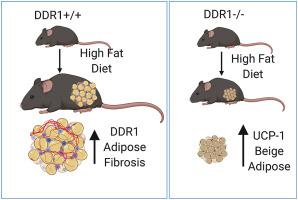Molecular Metabolism ( IF 7.0 ) Pub Date : 2020-04-28 , DOI: 10.1016/j.molmet.2020.101006 Marsel Lino 1 , David Ngai 1 , Alison Liu 1 , Amanda Mohabeer 1 , Cameron Harper 1 , Laura-Lee Caruso 1 , Stephanie A Schroer 2 , Fred Fu 3 , Trevor McKee 3 , Adria Giacca 4 , Minna Woo 2 , Michelle P Bendeck 1

|
Objective
Discoidin domain receptor 1 (DDR1) is a collagen binding receptor tyrosine kinase implicated in atherosclerosis, fibrosis, and cancer. Our previous research showed that DDR1 could regulate smooth muscle cell trans-differentiation, fibrosis and calcification in the vascular system in cardiometabolic disease. This spectrum of activity led us to question whether DDR1 might also regulate adipose tissue fibrosis and remodeling.
Methods
We have used a diet-induced mouse model of cardiometabolic disease to determine whether DDR1 deletion impacts upon adipose tissue remodeling and metabolic dysfunction. Mice were fed a high fat diet (HFD) for 12 weeks, followed by assessment of glucose and insulin tolerance, respiration via indirect calorimetry, and brown fat activity by FDG-PET.
Results
Feeding HFD induced DDR1 expression in white adipose tissue, which correlated with adipose tissue expansion and fibrosis. Ddr1−/− mice fed an HFD had improved glucose tolerance, reduced body fat, and increased brown fat activity and energy expenditure compared to Ddr1+/+ littermate controls. HFD-fed DDR1−/− mice also had reduced fibrosis, smaller adipocytes with multilocular lipid droplets, and increased UCP-1 expression characteristic of beige fat formation in subcutaneous adipose tissue. In vitro, studying C3H10T1/2 cells stimulated to differentiate, DDR1 inhibition caused a shift from white to beige adipocyte differentiation, whereas DDR1 expression was increased with TGFβ-mediated pro-fibrotic differentiation.
Conclusion
This study is the first to identify a role for DDR1 as a driver of adipose tissue fibrosis and suppressor of beneficial beige fat formation.
中文翻译:

在心脏代谢性疾病小鼠模型中,盘状蛋白结构域受体1的缺失改善了纤维化并促进了脂肪组织的变黄,褐色脂肪活性和新陈代谢速率的提高。
目的
Discoidin域受体1(DDR1)是胶原结合受体酪氨酸激酶,与动脉粥样硬化,纤维化和癌症有关。我们先前的研究表明,DDR1可以调节心脏代谢疾病中血管系统的平滑肌细胞转分化,纤维化和钙化。这种活动范围使我们质疑DDR1是否也可以调节脂肪组织的纤维化和重塑。
方法
我们已经使用饮食诱导的心脏代谢性疾病小鼠模型来确定DDR1缺失是否对脂肪组织重塑和代谢功能障碍产生影响。给小鼠喂食高脂肪饮食(HFD),持续12周,然后评估葡萄糖和胰岛素耐受性,通过间接量热法进行的呼吸作用以及通过FDG-PET进行的棕色脂肪活动。
结果
进食HFD可以诱导DDR1在白色脂肪组织中的表达,这与脂肪组织的扩张和纤维化有关。与Ddr1 + / +同窝仔对照相比,喂食HFD的Ddr1 -/-小鼠具有改善的葡萄糖耐量,减少的体内脂肪以及增加的棕色脂肪活性和能量消耗。由HFD喂养的DDR1 -/-小鼠还具有减少的纤维化,较小的脂肪细胞和多眼脂质滴,以及在皮下脂肪组织中米色脂肪形成的UCP-1表达特征增加。在体外,研究了受刺激分化的C3H10T1 / 2细胞,DDR1抑制作用导致脂肪细胞从白色转变为米色,而DDR1表达随TGFβ介导的促纤维化分化而增加。
结论
这项研究是首次确定DDR1作为脂肪组织纤维化的驱动器和有益的米色脂肪形成的抑制剂的作用。











































 京公网安备 11010802027423号
京公网安备 11010802027423号